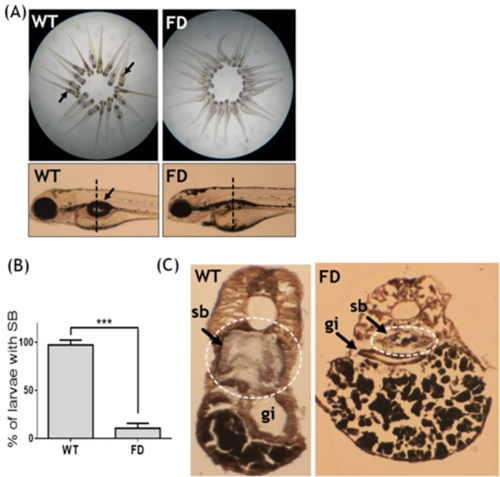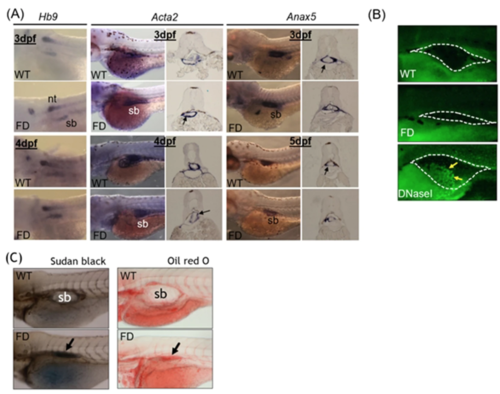- Title
-
A novel zebrafish model to emulate lung injury by folate deficiency-induced swim bladder defectiveness and protease/antiprotease expression imbalance
- Authors
- Lee, G.H., Cheng, N.W., Yu, H.H., Tsai, J.N., Liu, T., Wen, Z.H., Chen, B.H., Fu, T.F.
- Source
- Full text @ Sci. Rep.
|
Defective swim bladder formation in FD larvae. Embryos of the zebrafish transgenic line Tg( hsp:EGFP-GGH) were heat-shocked at 9- and 24-hpf to induce folate deficiency and observed for swim bladder development at 5 dpf. ( A,B) The clear bubble-like swim bladders (black arrows) were observed in almost all 5 dpf wild-type larvae but were absent in more than 80% of FD larvae. Data are reported as the means ± SD, n = 20 (20 independently conducted repeats with at least a total of 500 larvae for each group), ***p < 0.001. ( C) The inflated chamber of swim bladder (the circled area indicated by arrows) is clearly seen in the elastin/collagen stained cross-sections (dash-line in ( A)) prepared from wild-type control larvae, but not in FD larvae. WT, wild-type; FD, folate deficiency; sb, swim bladder; gi, gastrointestinal tract. PHENOTYPE:
|
|
The tissue integrity and pathology of the swim bladder in wild-type and FD embryos and larvae. Heat-shocked larvae of both wild-type control and Tg( hsp:EGFP-GGH) were harvested at indicated stages post embryogenesis and analyzed for swim bladder development. ( A) Embryos were subjected to WISH with tissues specific probes including Hb9 (epithelial layer), Acta2 (mesenchyme layer, smooth muscle) and Anax5 (outer mesothelium layer). Cross-sections of the embryos after WISH staining revealed comparable intensity and morphology for the tissue layers composed of swim bladders (black arrows) in the early embryos. ( B) Larvae at 5 dpf examined with TUNEL assay for apoptotic cells (arrows) revealed no positive signal in the swim bladder area (circled by dash-line) of both wild-type control and FD larvae. Embryos pre-treated with DNase I served as a positive control. ( C) Larvae at 5 dpf were stained with Sudan black (left) and Oil red O (right) to reveal outlines of swim bladder (black arrows) in larvae. nt, neural tube; sb, swim bladder; WT, wild-type larvae with heat-shock; FD, FD larvae with heat-shock. EXPRESSION / LABELING:
|
|
The expression of cathepsin L and CTSB-like during zebrafish embryogenesis. Wild-type embryos were analyzed with whole-mount in situhybridization (WISH) at the indicated stages with antisense riboprobes against cathepsin L ( A) and CSTB-like ( B) for mRNA distribution. ( A) No appreciable signal for cathepsin L was observed in embryos before 8 hpf. Signals were significant in 12 hpf embryos at anterior prechordal plate (app) and subsequently in hatching gland (hg) at later stages. Signals were also abundant in the head region and swim bladder (sb) of 4-dpf larvae, which can be observed more clearly in a post-WISH cross-section at the trunk region (dash line and black arrow in inset). ( B) Intensive expression and homogenous distribution of CSTB-like transcripts were observed in embryos before 4 hpf. Signals became focused anteriorly in 1 dpf embryos and gradually diminished, as development proceeded, but nonetheless persistent in the trunk region along the vessels. Significant distribution appeared in the heart and the uninflated swim bladder area of 4 dpf larvae and became enriched in the region surrounding swim bladder at 5 dpf. app, anterior prechordal plate; h, heart; hg, hatching gland; sb, swim bladder. |

Unillustrated author statements |



